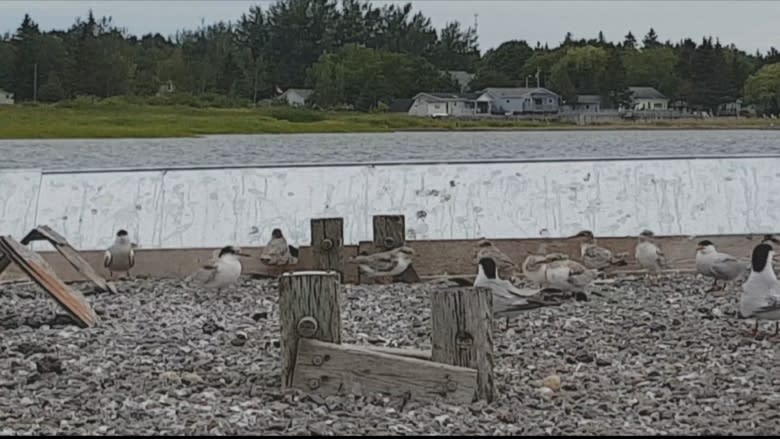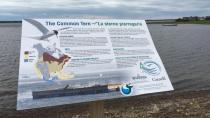Common terns return with the help of Shediac group
A colony of common terns in the Shediac Bay area is slowly rebuilding with the help of a new protective barrier around their nesting platform that a local group created.
The Shediac Bay Watershed Association added metal guards around the perimeter of the floating platform to help protect the terns' nests from predators.
"That will prevent anything from climbing up from shore," said Jolyne Hébert, environmental technician for the watershed association.
"So far so good," she said.
Last summer, terns on the platform were attacked by an unknown predator, devastating most of their nests.
"We're considering it pretty much a total loss for last year," Hébert said.
But this year, a June survey revealed 50 nests with 99 eggs, she said.
Happy with the terns' return
Mary and Cam Murphy, who have lived in Pointe-Du-Chêne for 16 years, said they're happy the birds are rebuilding.
"We love the birds," said Mary, who can see and hear terns from the back family room.
In recent years, the terns caused tension between some local people and the marina community, where boaters complained about being attacked by the birds.
"These birds are very territorial and very protective of their eggs and chicks," Hébert said. "So when people used to go to their boats they would often be attacked by the birds."
But since the nesting platform went up, those days seem to be over, Cam Murphy said.
"We think it's very useful for the birds and something they needed because at the marina in Shediac, the birds were attacking everybody, and out here they haven't attacked us once," he said.
"As far as noise, we don't hear them and we see them flying around once in a while. I think it's a worthwhile thing if you want the species to continue surviving, you have to have a nesting place for them."
The platform decision
In 2014, the association built a small platform after the sunken barge the terns were using to lay their eggs was replaced with a rock wall at the Shediac marina.
"All we've done is basically given them a place to lay their eggs," Hébert said.
Each year, the group has tried to improve the platform. In 2016, it expanded the platform using old docks.
"The common tern will only nest on habitat that is not connected to a land mass, such as an island or a sand dune," she said.
Hébert said the new metal guards help the colony defences against most land predators, including foxes, raccoons and muskrats, but not completely from aerial predators.
Hébert said the terns have been losing habitat each year because of climate change.
"It's becoming more and more difficult for them to find places to nest," she said.
Not all terns in the area nest on the platform. Some have found nesting ground at a sand dune.
Hébert is hopeful the young terns will survive until migration down south later this summer.










